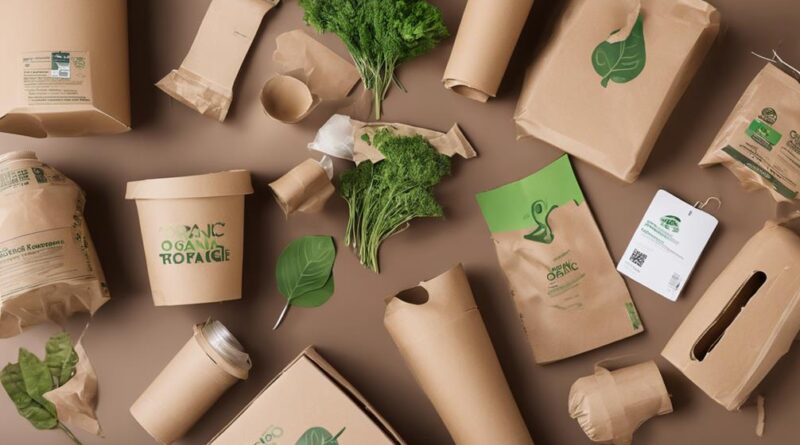Essential Steps for Organic Packaging Certification
To achieve organic packaging certification, you must first understand the industry standards. Identify certification requirements to ensure compliance. Choose accredited certification bodies carefully, focusing on auditor qualifications, documentation, and reputation. Complete the application and audit process meticulously, detailing all packaging practices. Receive certification by preparing necessary documentation, training staff, and ensuring compliance. Maintain certification by staying informed on regulations and adhering to standards. Hint: More insights await on the steps involved in the certification process.
Understanding Organic Packaging Standards
When seeking organic packaging certification, understanding the intricate standards is crucial for ensuring compliance and credibility in the market. By delving into the world of organic packaging standards, you equip yourself with the knowledge necessary to navigate the certification process effectively. One of the key benefits of understanding these standards is the ability to align your packaging practices with environmentally conscious principles, meeting the growing market demand for sustainable solutions.
However, this understanding also comes with its challenges. Navigating the nuances of certification standards can be complex and time-consuming. It requires a keen eye for detail and a commitment to meeting the stringent requirements set forth by certifying bodies. Despite these challenges, the benefits of organic packaging certification are well worth the effort.
Certification standards for organic packaging encompass a wide range of criteria, including sourcing materials from organic farms, using eco-friendly production processes, and ensuring biodegradability or compostability of packaging materials. Meeting these standards not only enhances the sustainability of your packaging but also boosts your credibility in a market where consumers are increasingly conscious of the environmental impact of their purchases.
Identifying Certification Requirements
To ensure successful organic packaging certification, a meticulous understanding of the specific requirements is paramount for aligning your practices with industry standards and gaining credibility in sustainable markets. When identifying certification requirements, it's crucial to focus on two key aspects: certification criteria and compliance checklist.
Certification criteria serve as the foundation for organic packaging certification. These criteria outline the specific guidelines and standards that your packaging materials and processes must meet to be considered organic. Understanding these criteria in detail is essential for ensuring that your packaging practices are in line with organic certification requirements. It involves aspects such as the types of materials allowed, sourcing methods, and processing techniques that are acceptable for organic packaging.
On the other hand, the compliance checklist provides a detailed list of items that need to be addressed and verified to demonstrate adherence to the certification criteria. This checklist acts as a roadmap for evaluating your packaging practices and ensuring that all necessary steps are taken to meet organic certification standards. By meticulously reviewing and addressing each item on the compliance checklist, you can enhance the likelihood of a successful organic packaging certification process.
Selecting Accredited Certification Bodies
Have you considered which accredited certification bodies align best with your organic packaging certification goals and values? When selecting an accredited certification body for your organic packaging certification, it's crucial to ensure that the body meets your specific requirements.
Here are some key aspects to consider:
- Auditor Qualifications: Look for certification bodies that have auditors with relevant experience and expertise in organic packaging. Ensure that the auditors are well-trained and knowledgeable about the specific requirements for organic certification in the packaging industry.
- Documentation Review: Choose a certification body that conducts thorough documentation reviews as part of the certification process. The certification body should carefully examine all your documentation related to the production process, materials used, and any other relevant information to ensure compliance with organic packaging standards.
- Industry Reputation: Consider the reputation of the certification body within the organic packaging industry. Look for reviews and feedback from other companies that have been certified by the body to gauge their satisfaction and the credibility of the certification process.
Selecting the right accredited certification body is a critical step in obtaining your organic packaging certification. By focusing on auditor qualifications, documentation review, and industry reputation, you can ensure a smooth certification process that aligns with your organic packaging goals and values.
Submitting Application for Certification
Consider the essential steps and documentation required when preparing your application for organic packaging certification.
The initial stage involves submitting your application to the chosen certification body. The certification body will then review your application to ensure it meets all the necessary requirements for organic packaging certification. This review process is crucial as it sets the foundation for the certification process.
Documentation requirements play a vital role in the application process. You must provide detailed documentation outlining your packaging materials, manufacturing processes, and any other relevant information required by the certification body. Ensuring that all documentation is accurate and up to date will facilitate the application review process and expedite the certification timeline.
Effective timeline management is essential when applying for organic packaging certification. It's crucial to stay organized and meet all deadlines set by the certification body. By proactively managing your application timeline, you can avoid delays in the certification process and ensure a smooth transition from application submission to certification approval.
Preparing for Certification Audit
When preparing for the certification audit, ensure all your packaging materials and manufacturing processes are meticulously documented for thorough review. Audit preparation is crucial for certification readiness.
To help you get ready for the audit, consider the following:
- Documented Procedures: Make sure all your packaging processes are well-documented, including sourcing organic materials, manufacturing practices, and quality control measures.
- Traceability Records: Keep detailed records of your supply chain, from the origin of raw materials to the final packaging stage. This will demonstrate the transparency and integrity of your organic packaging process.
- Employee Training Programs: Implement training programs for your staff to ensure everyone understands the importance of organic certification standards. Well-trained employees are key to maintaining compliance with organic packaging requirements.
Implementing Corrective Actions (If Needed)
Ensure that any identified deficiencies or non-compliances are promptly addressed and rectified to maintain the integrity of your organic packaging certification. Implementing corrective actions, if needed, is crucial in ensuring that your packaging processes align with organic standards. Begin by documenting the specific issues identified during the certification audit. This documentation will serve as a roadmap for the improvements needed in your packaging procedures.
Once the deficiencies are identified, prioritize them based on their impact on organic compliance. Implement corrective actions systematically, addressing the most critical issues first. This approach allows you to make progress efficiently while continuously monitoring the effectiveness of the implemented changes.
Regularly monitor the progress of your corrective actions to ensure that the improvements are effective in addressing the identified deficiencies. This monitoring process may involve conducting internal audits or reviews to assess the ongoing compliance of your packaging operations with organic standards.
As you implement corrective actions, focus on making sustainable improvements to prevent future non-compliances. Incorporate feedback from employees involved in the packaging process to ensure that the implemented changes are practical and sustainable in the long run. By actively monitoring the progress of these corrective actions, you can maintain the integrity of your organic packaging certification and demonstrate your commitment to organic standards.
Receiving Organic Packaging Certification

Upon successfully addressing any deficiencies and implementing corrective actions, the next step in the organic packaging certification process is receiving the official certification. To achieve this, you must focus on preparing documents and training employees effectively. Here are some essential steps to help you receive your organic packaging certification:
- Preparing Documents: Gather and organize all the necessary paperwork required for the certification process. This may include documentation related to your packaging materials, sourcing methods, and production processes. Make sure that all documents are accurate, up-to-date, and in line with organic packaging standards.
- Training Employees: Conduct training sessions to educate your team about the requirements and protocols associated with organic packaging. Ensure that all employees involved in the packaging process understand their roles and responsibilities in maintaining organic certification standards. Training sessions can help create a culture of compliance within your organization.
- Final Review: Before submitting your certification application, conduct a final review of all documents and procedures to ensure everything is in order. Double-check that your packaging materials meet organic standards, employees are trained appropriately, and all necessary paperwork is complete. This step will help you avoid any last-minute issues that could delay the certification process.
Maintaining Compliance and Renewal
To uphold your organic packaging certification, it's imperative to consistently adhere to compliance requirements and plan for the timely renewal process. Staying compliant with organic packaging standards involves staying up to date with the latest regulations and ensuring that your packaging materials meet the necessary criteria. Regularly review your processes to identify any areas that may need improvement to remain in compliance with organic certification requirements.
When it comes to the renewal process, it's crucial to start planning well in advance of your certification expiration date. Begin by reviewing the renewal guidelines provided by the certification body to understand the specific requirements and deadlines. Make a checklist of all the documents and information needed for renewal to ensure a smooth and efficient process.
As part of maintaining compliance and preparing for renewal, stay informed about any updates or changes in organic packaging regulations. Attend training sessions or workshops to enhance your understanding of the requirements and how they may impact your packaging practices. Implement any necessary changes promptly to avoid non-compliance issues during audits or inspections.
Conclusion
Congratulations on completing the essential steps for organic packaging certification.
By understanding the standards, identifying requirements, selecting accredited bodies, submitting applications, preparing for audits, implementing corrective actions, and ultimately receiving certification, you have demonstrated your commitment to sustainability and quality.
Maintain compliance, stay proactive in renewal processes, and continue to uphold the principles of organic packaging.
Your dedication to these steps will ensure the integrity of your products and build trust with consumers.
